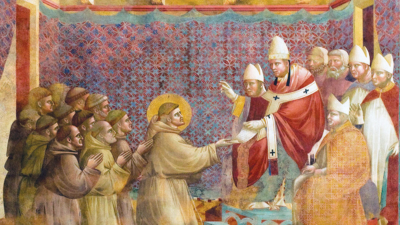An Approved Rule of Franciscan Life
St. Francis of Assisi
The growth of the Order, the clear need for rules and directions, and the Church’s requirement for written, formal “rules of life” – and the Friars prepared their Rule.

The year is 1221 and at the request of the “cardinal protector” of the friars, Cardinal Hugolino, Francis and several of his brothers have taken up the task of writing a formal rule of life. It was not clear that the Franciscans were actually a “religious order.” When Francis visited Pope Innocent III in 1209, the pope verbally approved (or did he?) a Rule of Life that was written down in few words. In 1216, the 4th Lateran Council ruled that no new religious orders could be formed: all new groups would be absorbed into existing religious orders. Hugolino recognized the uniqueness of the charism of St. Francis and his brothers and was determined that it not be lost to the church.
Francis and some companions undertook the writing of the “early rule” also known as the Rule of 1221. It is a potpourri of spiritual reflections, exhortations, and communal and individual norms of behavior – all animated by extensive citations from Scripture. Even though Francis was attempting to write a juridical rule of life that would “pass muster” from the canon lawyers in the Roman Curia, at the same time he was trying to write a rule borne out of his lived experience of following Christ and the pathway that was revealed to him: “God has called me to walk in the way of humility and showed me the way of simplicity. I do not want to hear any talk of the rule of Saint Augustine, of Saint Bernard, or of Saint Benedict. The Lord has told me that he wanted to make of me a new fool in the world, and God does not want to lead us by any other knowledge than that.” (Assisi Compilation, 18)
The rule was finished, shown to Hugolino (we do not know of his reaction), and submitted to the Roman Curia. We know the end result. There is a reason why the “early rule” or “Rule of 1221” is more formally known as the regula non bullata – it was rejected. But undaunted, Francis and his brothers rolled up their sleeves and went to work on a more streamlined rule, one more suited to the tastes of the canon lawyers. This “later rule” or “Rule of 1223” is known as the regula bullata because it was formally issued under the Papal Bull (seal) Solet annuere. It conferred on the Franciscans the official status of “Order” as a juridical foundation.
The document was the most the Curia would accept and was far less than Francis wanted, even if it remained faithful to his fundamental intuitions of the way of life God had showed to him. For the next three years of his life, Francis worked to continue to give example, a living testimony, of the manner and meaning of the approved rule – and at the end of his life Francis wrote his Testament, a clear indication of what Francis wanted for the order: live under the Rule of 1223 – but hold the Rule of 1221 close to your heart. Here is one example of the differences between the two rules:

The Rule of 1221 and the Testament, even though not juridically approved, reveal the soul and passion of St. Francis, and as such are the “go to” texts when Franciscans study what it means to be “friar minor.”